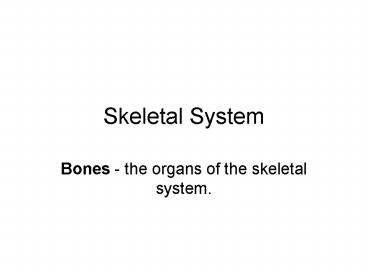Skeletal System - PowerPoint PPT Presentation
Title:
Skeletal System
Description:
Skeletal System Bones - the organs of the skeletal system. 2 Divisions The human skeleton has two divisions Axial skeleton Consist of the skull, vertebrate column ... – PowerPoint PPT presentation
Number of Views:213
Avg rating:3.0/5.0
Title: Skeletal System
1
Skeletal System
- Bones - the organs of the skeletal system.
2
2 Divisions
- The human skeleton has two divisions
- Axial skeleton Consist of the skull, vertebrate
column, and the rib cage - The Appendicular Skeleton - Consist the bones of
the arms and legs, shoulder, and the pelvic
girdle . - The Skeleton of Humans is composed of a special
connective tissue called BONE - There are 206 bones in the human body
3
Meet BONES
4
Functions of the Skeletal System
- support - it forms the body's framework to
support the muscles and organs. - protection - the skeletal systems protects by
- 1) forming the bony cavities around organs,
- the thoracic cavity protects the heart and lungs
- the cranial cavity protects the brain.
- 2) the yellow marrow in bones produces white
blood cells which protect against invading
microorganisms. - movement - bones form joints which provide levers
for movement such as walking, lifting, etc. - hematopoiesis (blood cell production) - the red
marrow produces red blood cells. - mineral storage and homeostasis - the skeleton
forms a reservoir of minerals, especially
calcium, for maintenance of homeostasis.
5
2 Basic types of bone tissue
- 1. Compact bone - dense, smooth. Contains few
spaces. Covers spongy bone tissue. Provides
protection and support and helps long bones
resist stress of weight. - 2. Spongy bone - composed of small needle-like
pieces and open spaces filled with red marrow.
Makes up most of short, flat and irregular shaped
bones and most of the epiphysis of long bones. - Bones are classified by their shape
- 1. Long bones (humerus, femur)2. Flat bones
(skull)3. Short bones (fingers)4. Irregular
bones (vertebrae)
6
(No Transcript)
7
Joints
- JOINTS WHERE TWO BONES MEET
- Cartilage is responsible for keeping bones far
enough apart so they do not rub against each
other as they move. At the same time, joints hold
the bones in place. - Joints work by attaching muscles which work in in
pairs - ANTOGONISTIC MUSCLES - flexors
extensors - Muscles attach to bone via connective tissue
called TENDONS - Bones attach to bones via connective tissue
called LIGAMENTS
8
There are two kinds of joints
- IMMOVABLE JOINT
- THEY ARE OFTEN CALLED FIXED JOINTS, AND ALLOW NO
MOVEMENT BETWEEN BONES. - These joints are interlocked and held together by
Connective Tissue, or they are fused together. - The places where the bones of the SKULL meet
(SUTURE) meet are examples of immovable joints. - Immovable joints are located in bones of the
skulls and the ribs - 2. MOVABLE JOINTS
- MOST OF THE JOINTS OF THE BODY ARE FREELY
MOVABLE JOINTS. - In Freely Movable Joints, the ends of the bones
are covered with a layer of Cartilage that
provides a smooth surface at the joint. Joints
are a place where two or more bones come
together. - Examples are the ball-and-socket, pivot, hinge,
and gliding
9
(No Transcript)
10
Moveable JointsBall-and-socket joint
- Ball-and-socket joints allow the greatest range
of motion. They can be found in the shoulder
where the top of the arm bone fits into the deep,
bowl-like socket of the scapula (shoulder blade).
- This joint allows you to swing your arm freely in
a circle, your hips also have ball-and-socket
joints
11
Moveable JointsHinge joint
- Permits a back-and-forth motion.
- The Knee enables your leg to flex and extend.
- The Elbow, which allows you to move your forearm
toward and away from your body.
12
Moveable JointsPivot Joint
- A pivot joint allows one bone to rotate around
another - A pivot joint can be found in the top of your
neck, which gives you limited ability to turn
your head from side to side
13
Moveable JointsGliding Joint
- A gliding joint allows one bone to slide over
another bone - The joint located in your wrist is an example of
a gliding joint this joint enables you to bend
and flex your wrist, as well as make limited
side-to-side motions.
14
Joint Activity
- What types of joints are involved in the
following activities - 1. Move your arm in a circle
- 2. Push open a door
- 3. Lift a book off the table
- 4. Kneel down
- 5. Wave your hand
- 6. Twist your head from side to side
- Answers
- 1. Arm ball-and-socket joint
- 2. Door hinge joint (elbow)
- 3. Book Gliding joint (wrist)
- 4. Kneeling hinge joint (knee)
- 5. Hand gliding joint (wrist)
- 6. Head Pivot joint (neck)































